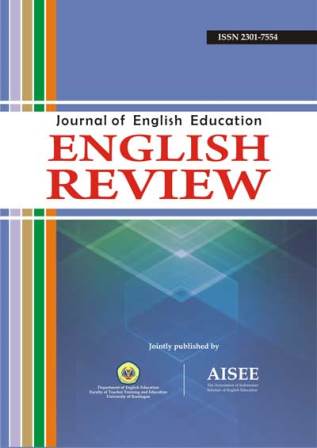THE COMPARISONS AND CONTRASTS BETWEEN ENGLISH AND MALAY LANGUAGES
Abstract
English and Malay languages are categorized as popular languages in the world. However, both languages underwent different history and composition. This study investigates the languages in terms of history, phonology, loanwords, grammar, morphology and semantics. The purposes of studying the comparisons and contrasts of both languages are not only to analyze the uniqueness of the languages but also to identify the process of understanding the languages especially the view of second language learners. It is found that two languages come from different background; somehow they share similar characteristics such as the vowels sounds, loanwords and semantics. However, the learners face difficulty in learning both languages especially in pronunciations and spelling.
Keywords: English language, Malay language, history of languageReferences
Asmah, O. (1983). The Malay Peoples of Malaysia and their languages. Kuala Lumpur: Dewan Bahasa & Pustaka.
Asmah, O. (1986). Nahu Mutakhir Melayu. Kuala Lumpur: Dewan Bahasa dan Pustaka.
Azar, B. (1989). Understanding and Using English Grammar. Prentice Hall Regents. New Jersey.
Baker, M. (2011). In other words: A course book on translation. 2nd ed. London: Routledge.
Butt, D., Fahey, R., Feez, S., Spinks, S., & Yallop, C. (2000). Using Functional Grammar. Sydney: National Centre for English Language Teaching & Research.
Deterding, D., & Salbrina, S. (2013). Brunei English: A new variety in a multilingual society. Dordrecht: Springer.
Halliday, M. A. K. (1994). An Introduction to Functional Grammar. London: Edward Arnold.
Hatim, B. (1997). Communication Across Cultures: Translation theory and contrastive text linguistics. Exeter: University of Exeter Press.
Hazita, A. (2004). Global English and English Literacy Education in Malaysia, in Penny Lee and Hazita Azman, Global English and Primary Schools: Challenges for Elementary Education, Melbourne: CAE Press.
Imran, H. A. (2000). Contrasting Malay - English Preposition Categories:
Indulging in In Diverse Voices: Readings in Languages, Literatures and Cultures. Serdang: Penerbit Universiti Pertanian Malaysia.
Khazriyati, S., Tan, K. H., & Marlyna, M. 2006. "Definiteness and
indefiniteness: A contrastive analysis of the use of determiners between the malay language and English". GEMA Online Journal of Language Studies. Volume 6 (1).
Marlyna, M., Khazriyati, S., & Tan, K. H. (2005). "Everyone People Must
Have a Best Friend. Interference of Malay Structures in English Written
Discourse". Proceedings of the TLEiA Conference. Teaching and Learning of
English: Towards an Asian Perspective. Fakulti Komunikasi dan Bahasa Moden:UUM.
Murni. M. (2013). ‘Fonetik dan fonologi (vokal & konsonan)’. Retrieved from http://www.slideshare.net/murnibintimohamat/fonetik-dan-fonologi-vokal-konsonan
Newmark, P. (1988). A Textbook of Translation. Singapore: Prentice Hall International (UK) Ltd.
Nik, S. K. (1989). Tatabahasa Dewan Jilid 2: Perkataan. Kuala Lumpur, Dewan Bahasa dan Pustaka.
Noorizah, M. N., & Rosniah, M. (1998) Tatabahasa Inggeris. Utusan Publications. Kuala Lumpur.
Nor, H. J. (2004). Penguasaan bahasa Melayu oleh pelajar Melayu
dalam arus globalisasi. Jurnal Bahasa Jil. 4 (1), 63-95.
Ramli, Md. S., Ismail. S., Idris. A., Fadzeli. J. (2000). Penguasaan Bahasa
Melayu di Kalangan Pelajar-Pelajar Sekolah Menengah Rendah: Kajian di
Sekolah-Sekolah Rancangan FELDA Negeri Sembilan. Universiti Kebangsaan Malaysia.
All articles published in English Review: Journal of English Education (ERJEE) are licensed under the Creative Commons Attribution 4.0 International License (CC BY 4.0).
Copyright Ownership
Authors retain the copyright of their articles and grant ERJEE the right of first publication. The journal is granted a non-exclusive license to publish, reproduce, and distribute the article in any format, medium, or platform, provided that proper credit is given to the original authors.
License Terms – CC BY 4.0
Under the Creative Commons Attribution 4.0 International License, others are free to:
- Share — copy and redistribute the material in any medium or format
- Adapt — remix, transform, and build upon the material for any purpose, even commercially
As long as they:
- Provide appropriate credit to the original author(s) and source
- Provide a link to the license (https://creativecommons.org/licenses/by/4.0/)
- Indicate if any changes were made
There are no restrictions on the reuse, reproduction, or adaptation of published articles as long as attribution is properly given.
Author Warranties
By submitting a manuscript to ERJEE, authors confirm that:
- The work is original and does not infringe any existing copyright.
- The manuscript has not been previously published and is not under consideration elsewhere.
- All sources and references are appropriately acknowledged.
- Necessary permissions have been obtained for any copyrighted materials used.










